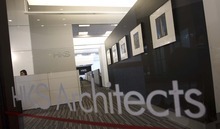This is an archived article that was published on sltrib.com in 2012, and information in the article may be outdated. It is provided only for personal research purposes and may not be reprinted.
Call them "starchitects" — rock stars of architecture.
Anticipation is running high after the announcement that high-profile HKS Architects Inc. and Pelli Clarke Pelli Architects will design the $110 million Utah Performing Arts Center slated for 137 S.Main St.
The 2,500-seat playhouse — which will be fashioned for touring Broadway shows as well as concerts and plays — is being billed as the centerpiece of the capital city's performing arts venues. Salt Lake City officials say when it opens in March 2016 it will spark new vitality downtown.
Pressure to perform? Well, maybe a little, concedes Michael Vela, managing partner for HKS in Salt Lake City. But he prefers to view it as an exciting challenge.
"People know what great architecture is, even if they can't verbalize it," he said. "There is a sense of 'Wow, this makes me feel great. I want to come back here.' "
The Dallas-based HKS has offices in a slew of U.S. and foreign cities and boasts a combined staff of about 900.
But Vela said he likes to think of the 14-year-old Salt Lake City office, which employs 20 people, as a local firm that knows Utah and its traditions.
On any given project, HKS can draw on companywide talent, said Brian Junge, design director for HKS Salt Lake City.
"We have the capability of building a strong team for each specific project," he said. "HKS has a deep bench."
But Junge added that the theater's design must take into account Utah's history. "That's an imperative of the design," he said, "that it feels like a piece of Salt Lake City."
The team approach for the Utah Performing Arts Center includes world-renowned designer César Pelli. His New Haven, Conn.-based firm, Pelli Clarke Pelli, has teamed with HKS on a number of large projects, said Helen Langan, senior adviser to Salt Lake City Mayor Ralph Becker and member of the selection committee that chose the two firms from among 14 applicants.
"They have designed some really stunning buildings and theaters all over the country," she said.
The most recent HKS-Pelli project is the ARIA Resort and Casino in Las Vegas, completed in 2009.
Their record of successful teamwork was important to the selection committee, said Jennifer Bruno, deputy director of the Salt Lake City Council staff and a member of the selection committee. "They have great chemistry together and a great track record working together."
Among the things that impressed her, Bruno noted, was the HKS-Pelli team's excitement when addressing the challenge of building the large theater in a confined urban setting. "They gave us confidence they could deliver, given the difficulty of this project."
The theater project is fraught with challenges, Vela noted. Main Street buildings must be demolished. Infrastructure must be rebuilt along with the theater itself — which has yet to be designed.
HKS will focus on the technical aspects of the design, Vela explained. While Pelli will home in on what the finished structure will look like to passers-by and theatergoers.
"We know and understand all the parts for a performing arts center," Vela said. "Every theater has a reputation, based on how easy it is to get everything set for a Broadway show — load in, get the curtain up and load out."
Most of that will never be seen by an audience of showgoers. It's what architects and designers call the "back of the house," Vela explained.
There are hundreds upon hundreds of details that must come together so that the theater functions smoothly — from the loading docks to the dressing rooms to the footlights.
"It's like a living Rubik's cube. All the elements have to work together," Vela said. "When all the pieces fall into the right place, it's the realization, of course, that's the way it should be."
In the end, the function will inform the front of the house — what the public and theater patrons see, hear and feel.
Salt Lake City-based architect David Hart, who oversaw renovation of the state Capitol, said HKS and Pelli bring the right experience to this specific project. Hart is the regional manager of MOCA Systems, consultants who represent Salt Lake City for the mega-theater project.
"I think we'll get the best of both worlds from this team," he said. "It will be on budget and will be a great contribution to our cultural arts centers."
And it will be a performing arts center for the whole community, said musician Kurt Bestor, who also was a member of the selection committee.
"They were looking at black box, dance, rehearsal areas," he said. "This is going to be something for the people. It can be rented by anybody — Plan-B Theatre, Sting or Bruce Springsteen could use it."
And he was delighted that César Pelli himself will have a hands-on approach.
"I don't know what it will look like," Bestor said. "But I know Salt Lake will be proud of it."
Utah Performing Arts Center public input
City officials and architects of the new downtown theater are seeking public input on the project at a workshop 5:30-8 p.m. Thursday, Oct. 11, in the fourth floor conference room at the Salt Lake City Public Library, 210 E. 400 South. To sign up for the workshop, visit http://www.utahperformingartscenter.org/oct-workshop.





